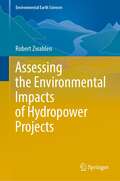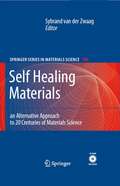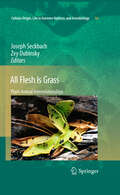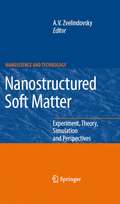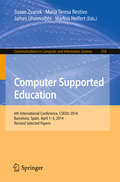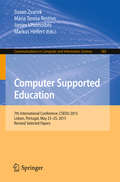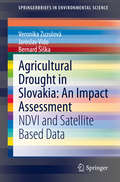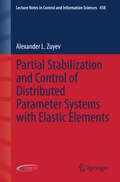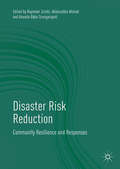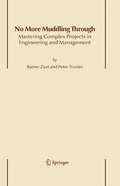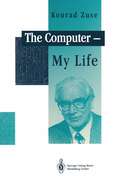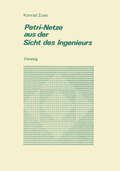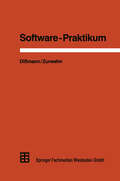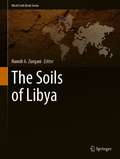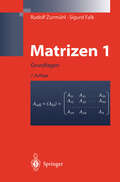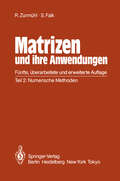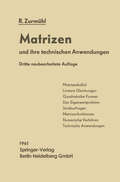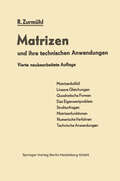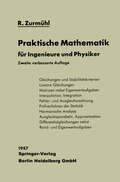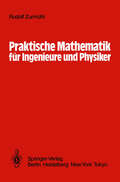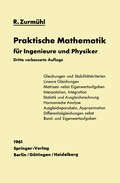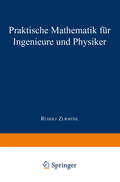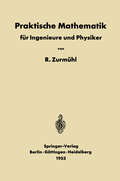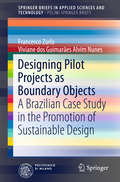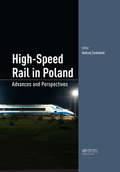- Table View
- List View
Assessing the Environmental Impacts of Hydropower Projects (Environmental Earth Sciences)
by Robert ZwahlenThis book describes the entire process of environmental impact assessment for hydropower and dam projects, not from a legal or regulatory point of view, but from a very applied one, based mainly on the personal experience of the author, who is involved in this field of work since over 40 years, by describing the different steps of such an assessment, covering all major aspects to be dealt with. The focus is on environmental issues, while the other main subject—social impacts—is mentioned here only briefly. It will be of interest not only for ESIA (Environmental and Social Impact Assessment) practitioners, be they consultants involved in the preparation of such studies or staff members of environmental protection agencies having to come to decisions based on them, but also for engineers and planners involved in such projects, developers, and people interested in questions related to energy, environment, and climate change. Overall, this book aims at contributing to put the discussion about hydropower and dam projects on a more objective level.
Self Healing Materials: An Alternative Approach to 20 Centuries of Materials Science (Springer Series in Materials Science #100)
by Sybrand Van Der ZwaagThis book, the first published in this new sub-field of materials science, presents a coherent picture of the design principles and resulting properties of self-healing materials over all material classes, and offsets them to the current design principles for structural materials with improved mechanical properties. The book is not only a valuable asset for professional materials scientists but it is also suitable as a text book for courses at MSc level.
All Flesh Is Grass: Plant-Animal Interrelationships (Cellular Origin, Life in Extreme Habitats and Astrobiology #16)
by Zvy Dubinsky and Joseph SeckbachThis new book takes us through a journey from early life to modern agriculture. The thirty eight authors present current studies on the interrelation of plants-animals. This topic has always fascinated man, as evidenced even by the first chapters of Genesis. The world of aqueous and terrestrial fauna appeared on early earth only after the flora covered the areas with the green pigmentation. Almost all life depends upon sunlight via the photosynthesis of the botanical world. We read abut the harnessing of bee pollination of crops to make it an essential component of modern agriculture endeavor. Some plants seduce insects for pollination by their appearance (e.g., disguised orchids entice visitors); there is the production of sweet nectar as a bribe in flowers to attract bees, butterflies, and honey-sucking birds. A particular outstanding phenomena are the carnivorous plants that have developed trapping and digesting systems of insects and higher animals.
Nanostructured Soft Matter: Experiment, Theory, Simulation and Perspectives (NanoScience and Technology)
by A. V. ZvelindovskyThis book provides an interdisciplinary overview of a new and broad class of materials under the unifying name Nanostructured Soft Matter. It covers materials ranging from short amphiphilic molecules to block copolymers, proteins, colloids and their composites, microemulsions and bio-inspired systems such as vesicles.
Computer Supported Education: 6th International Conference, CSEDU 2014, Barcelona, Spain, April 1-3, 2014, Revised Selected Papers (Communications in Computer and Information Science #510)
by Susan Zvacek Maria Teresa Restivo James Uhomoibhi Markus HelfertThis book constitutes the refereed proceedings of the 6th International Conference on Computer Supported Education, CSEDU 2014, held in Barcelona, Spain, in April 2014. The 24 revised full papers presented were carefully reviewed and selected from 242 submissions. The papers address topics such as information technologies supporting learning; learning/teaching methodologies and assessment; social context and learning environments; domain applications and case studies; and ubiquitous learning.
Computer Supported Education: 7th International Conference, CSEDU 2015, Lisbon, Portugal, May 23-25, 2015, Revised Selected Papers (Communications in Computer and Information Science #583)
by Susan Zvacek Maria Teresa Restivo James Uhomoibhi Markus HelfertThis book constitutes the refereed proceedings of the 7th International Conference on Computer Supported Education, CSEDU 2015, held in Lisbon, Portugal, in May 2015. The 34 revised full papers presented together with an invited talk were carefully reviewed and selected from 196 submissions. The papers address topics such as information technologies supporting learning; learning/teaching methodologies and assessment; social context and learning environments; domain applications and case studies; and ubiquitous learning.
Agricultural Drought in Slovakia: NDVI and Satellite Based Data (SpringerBriefs in Environmental Science)
by Veronika Zuzulová Jaroslav Vido Bernard ŠiškaThis book gives an insight into the evaluation of drought in Slovakia and provides an assessment of Normalized Difference Vegetation Index (NDVI) as a method suitable for an evaluation of drought in agricultural land. Dry seasons in the time series from 1960 to 2014 were determined according to the monthly Palmer Drought Severity Index (PDSI). The field research was carried out on 12 sites including western Slovakia, Prešov, Trnava and Nitra regions. Data collected from satellite imagery, climate data analyses and drought indices was analysed to determine the value of NDVI as an evaluation tool.
Partial Stabilization and Control of Distributed Parameter Systems with Elastic Elements (Lecture Notes in Control and Information Sciences #458)
by Alexander L. ZuyevThis monograph provides a rigorous treatment of problems related to partial asymptotic stability and controllability for models of flexible structures described by coupled nonlinear ordinary and partial differential equations or equations in abstract spaces. The text is self-contained, beginning with some basic results from the theory of continuous semigroups of operators in Banach spaces. The problem of partial asymptotic stability with respect to a continuous functional is then considered for a class of abstract multivalued systems on a metric space. Next, the results of this study are applied to the study of a rotating body with elastic attachments. Professor Zuyev demonstrates that the equilibrium cannot be made strongly asymptotically stable in the general case, motivating consideration of the problem of partial stabilization with respect to the functional that represents “averaged” oscillations. The book’s focus moves on to spillover analysis for infinite-dimensional systems with finite-dimensional controls. It is shown that a family of L2-minimal controls, corresponding to low frequencies, can be used to obtain approximate solutions of the steering problem for the complete system.The book turns from the examination of an abstract class of systems to particular physical examples. Timoshenko beam theory is exploited in studying a mathematical model of a flexible-link manipulator. Finally, a mechanical system consisting of a rigid body with the Kirchhoff plate is considered. Having established that such a system is not controllable in general, sufficient controllability conditions are proposed for the dynamics on an invariant manifold.Academic researchers and graduate students interested in control theory and mechanical engineering will find Partial Stabilization and Control of Distributed-Parameter Systems with Elastic Elements a valuable and authoritative resource for investigations on the subject of partial stabilization.
Disaster Risk Reduction: Community Resilience and Responses
by Bupinder Zutshi Akbaruddin Ahmad Ananda Babu SrungarapatiThis book discusses the interconnected, complex and emerging risks in today’s societies and deliberates on the various aspects of disaster risk reduction strategies especially through community resilience and responses. It consists of selected papers presented at the World Congress on Disaster Management, which focused on community resilience and responses towards disaster risk reduction based on South Asian experiences, and closely examines the coordinated research activities involving all stakeholders, especially the communities at risk. Further, it narrates the experiences of disaster risk-reduction in different communities that have policy implications for mitigation of future disaster risks in the societies affected by these types of disasters. Written from the social science perspective to disasters rather than an engineering approach, the book helps development and governance institutions to prioritize disasters as a problem of development rather than being parallel to it.
No More Muddling Through: Mastering Complex Projects in Engineering and Management
by Rainer Züst P. TroxlerSustainable solutions require the integration of social and ecological aspects in every planning and decision-making process. This book explains the most important principles and elements of Systems Engineering and three planning cases demonstrate the practical application. It provides an understandable guide with questions and recommendations, and offers a clear structure of the problem solving process.
Software-Praktikum: Ein praxisorientiertes Vorgehen zur Software-Erstellung
by Volker ZurwehnDie Entwicklung von Software-Produkten wird heute als ingenieur mäßiges Vorgehen betrachtet, das sich der Verfahren der Software Technologie bedient. Die Anwendungen dieser Verfahren werden durch Werkzeuge unterstützt, deren Einsatz jedoch ein breites software-technologi sches Basiswissen erfordert. Dieses Wissen mu ß frühzeitig während der Ausbildung erworben werden. Wesentliche Voraussetzung für den professionellen Einsatz von Werkzeugen ist das Begreifen von Prinzipien, Methoden und Konzepten der Software Technologie. Daneben sind jedoch auch Erfahrungen des Entwicklers in der Gestaltung von Software-Produkten und im Umgang mit den zugrundeliegen den Verfahren notwendig. Erfahrung kann nur durch das praktische Anwenden erarbeitet werden. Der Praxisbezug und die praktische Arbeit besitzen somit bei der Vermittlung von Kenntnissen aus dem Bereich der Software Technologie in der Ausbildung von Informatikern eine besondere Bedeutung. Der Erwerb erster Erfahrungen in der systematischen, verfahrensunterstützten Software-Entwicklung erfolgt im Studiengang Informatik an der Universität Dortmund in der Lehrveranstaltung "Software-Praktikum". Studenten des Grundstudiums mit Kenntnissen in mindestens einer höheren Programmier sprache entwickeln in Gruppen zu zehn Teilnehmern in einem Semester gemeinsam Software-Produkte.
The Soils of Libya (World Soils Book Series)
by Hamdi A. ZurqaniThis book presents the soil pedodiversity in Libya. Soils are the source of all life; there can be no life without them. Further, each soil has its own history and its present conditions, which have been shaped by many different factors (e.g. climate, biota, parent material, and relief or topography). The book, divided into eight chapters, provides extensive information on Libyan soils. Chapter one provides an introduction and a broad perspective of the subject, while Chapter two covers the history of soil mapping and research in Libya. Chapter three focuses on local factors of soil formation and describes the geology and climate of the region to explain the diversity of its soils. Chapter four discusses soil classification systems and those most commonly used in the country. The fifth chapter illustrates the constraints and limiting factors that negatively affect agricultural activities across the country. The land cover/land use and the vegetation of the country are described in Chapter six. In turn, Chapter seven presents the status quo of soil biology, the corresponding related research activities, and the other biological properties of Libyan soils. The final chapter (Chapter eight) focus on land degradation and desertification in Libya, emphasizing the main causes, impacts of the phenomena, and efforts to combat it. This book demonstrates the problems that the country is currently facing as a result of climate change, soil erosion, salinization, and pollution, and outlines potential remedies to improve local food security. Bringing together the perspectives and expertise of many distinguished scientists from various universities and institutions in and outside of Libya, the book represents a unique and highly valuable resource.
Matrizen und ihre Anwendungen 1: Grundlagen Für Ingenieure, Physiker und Angewandte Mathematiker (Klassiker der Technik #30)
by Rudolf Zurmühl Sigurd FalkDas Buch behandelt Matrizengleichungen und -funktionen sowie die computergerechte Darstellung und Lösung der Bewegungsgleichungen von Schwingungssystemen mit endlich vielen Freiheitsgraden und führt in die Grundlagen der Näherungsmethoden von Rayleigh und Ritz ein. Das Eigenwertproblem wird, anders als sonst üblich, von einem allgemeinen Standpunkt aus betrachtet. Dadurch gewinnt die Darstellung an Verständlichkeit und an Anwendungsbreite. Das Buch ist sowohl für Studierende als auch für Physiker und Ingenieure in der Praxis geschrieben.
Matrizen und ihre Anwendungen für Angewandte Mathematiker, Physiker und Ingenieure: Teil 2: Numerische Methoden
by Rudolf Zurmühl Sigurd FalkPraktische Mathematik: für Ingenieure und Physiker
by Rudolf ZurmühlDas Buch ist gedacht als eine Ergänzung und Fortführung der mathematischen Grundlagenvorlesung der Technischen Hochschule. Es möchte den jungen Ingenieurstudenten zu einer über diese Vorlesung hinausgehenden Beschäftigung mit jenem Zweig der Mathematik an regen, der für die zahlenmäßige Behandlung von Ingenieuraufgaben aller Art grundlegend ist: mit den numerischen V erfahren der praktischen Mathematik. In diese Methoden, ihre Theorie und ihre praktische Hand habung führt es ein, wobei gleicher Wert auf klare Entwicklung der theoretischen Grundgedanken wie auf Einzelheiten der Zahlen rechnung gelegt wird. Aber auch dem in der Praxis tätigen Ingenieur möchte das Buch eine Hilfe sein, wenn er bei der Durchführung seiner Aufgaben vorder Notwendigkeit steht, auf numerische V erfahren zurück zugreifen. Ein Buch, das sich an Ingenieure und Physiker wendet, muß in mancher Hinsicht anders abgefaßt sein als ein für Mathematiker be stimmtes. Es soll gewiß nicht weniger zuverlässig und einwandfrei sein. Aber während der Mathematiker in die Lage versetzt werden soll, selbst aktiv an der Entwicklung neuer Methoden mitzuarbeiten, sollen Physi ker und Ingenieur in erster Linie die praktische Handhabung der Metho den erlernen, um sie als Hilfsmittel für ihre eigentliche Berufsarbeit anzuwenden. Damit sie das sinnvoll und richtig können, müssen sie freilich die mathematischen Grundlagen eines Verfahrens voll verstan den haben. Mit einer bloßen Rezeptsammlung ist auch ihnen durchaus nicht gedient.
Praktische Mathematik für Ingenieure und Physiker
by Rudolf Zurmühl426 man fordert also Anfangs- und Endordinate der Lösung y (x) im Inter vall (a, b), Abb. 112. An Stelle der Randordinaten (sogenannte erste Randwertaufgabe) lassen sich auch die Randsteigungen y' (a), y' (b) . Y fordern (zweite Randwertaufgabe) oder schließ lich eine Linearkombination zwischen Ordinaten und Steigungen (dritte Randwertaufgabe). Alle jl diese Aufgaben oder auch ihre Kombinationen treten in den Anwendungen auf. . :c Ähnlich wie bei der Anfangswertaufgabe wird Abb. 112 Zur Randwertaufgabe man bei formelmäßiger Lösung versuchen, die in der allgemeinen Lösung enthaltenen freien Integratlonskonstanten aus den beiden Randbedingungen zu bestimmen und so die fragliche Sonderlösung y(x) festzulegen. Prinzipiell scheint sich gegenüber der Anfangswertaufgabe damit kaum etwas geändert zu haben. Bei der Durchführung derartiger Aufgaben aber zeigt sich sehr bald, daß sie im Gegensatz zur Anfangswertaufgabe nicht mehr in jedem Falle lösbar sind. Es treten hier also neue charakteristische Schwierigkeiten auf, zu deren Überwindung besondere Überlegungen notwendig werden. Aber auch die Behandlungsmethoden, insbesondere die uns vornehmlich interessierenden Näherungsverfahren, sind von denen der Anfangswertaufgaben grundverschieden, so daß wir es hier in der Tat mit einem neuen und im übrigen höchst reizvollen Gebiet der praktischen Mathematik zu tun haben, bei dem auch theoretische Fragen mehr als bisher in den Vordergrund treten werden. Die charakteristische Schwierigkeit des Randwertproblems sei an folgendem einfachen Beispiel erläutert. 1. Beispiel: Gegeben sei die - lineare - Differentialgleichung y" + y = 0 mit den Randbedingungen y(O) = 1, y(2) = O.
Designing Pilot Projects as Boundary Objects: A Brazilian Case Study in the Promotion of Sustainable Design (SpringerBriefs in Applied Sciences and Technology)
by Francesco Zurlo Viviane dos NunesThis book describes a collaborative Design Pilot Project held in Brazil (called MODU.Lares) involving micro and small enterprises and other actors in the furniture sector. The experience was based on an action research method and evaluated by using a tool, in order to assess the value of pilot project as a boundary object capable of fostering innovation and sustainability. The impact of the Design Pilot Project in triggering change in a fragmented local system with a poor environmental and social record, as well as management and innovation issues, were assessed with the help of the same tool, taking into account environmental, technological, economic, sociocultural, and organizational indicators. The collaborative network established was chiefly based on four elements: prototypes, meetings, exhibitions and the Pilot Project (as an overall process). The results indeed demonstrate that a Design Pilot Project can be a valid instrument for establishing a collaborative environment that promotes sustainability and innovation, particularly in contexts with a weak associative culture. Such collaborative projects can constitute the first step in a design policy cycle in developing countries, contributing to the definition of ideas and objectives among local stakeholders, minimizing the risks of failure, and increasing the chances of receiving governmental support.
High-Speed Rail in Poland: Advances and Perspectives
by Andrzej ZurkowskiThe Railway Research Institute (Instytut Kolejnictwa) in Warsaw was established in 1951 and was, until 2000, part of the Polish State Railways (PKP). At present, it serves as an independent entity, it is subordinated to the minister responsible for transport. Since its inception, the Institute has been the centre of competence for technology, technique and organization of operation and services in rail transport, particularly in respect to innovation. One of its fundamental tasks also includes activities connected with safety which are carried out in close cooperation with the National Safety Authority, i.e. the Office of Rail Transport. At the same time the Institute participated in the process of upgrading and modernization of the rail network in Poland. Experience in high speed rail, gained as a result of international cooperation and basing on the effort to increase speed on railway lines in Poland (so far 200 km/h), is included in the monograph “Koleje Dużych Prędkości w Polsce” (High Speed Rail in Poland) published in 2015 for the benefit of the Polish reader. This monograph aims at reaching an international audience of experts so as to present Polish determinants of HSR implementation. In order to elaborate this monograph, apart from specialists from the Railway Research Institute, experts from other research and academic centres were invited. Not only presenting a wide range of problems connected with future construction of High Speed Lines in Polish conditions, but also a number of operational ones. The authors have created a reference work of universal character, solving problems in order to build and operate high speed rail systems in countries on a similar level of development as Poland. Features: providing requirements for design and upgrade of engineering works on High Speed Rail development information on restructuring and building railway lines for countries starting to develop a High Speed Rail system dealing with organizational, engineering, socioeconomic and economic demands for transport services and the formation of human resources for constructing and operting a High Speed Rails system. Presenting these problems on the international arena will facilitate future cooperation and application of world experience to create HSR in Poland and integrate the Polish HSR network into the international one.
